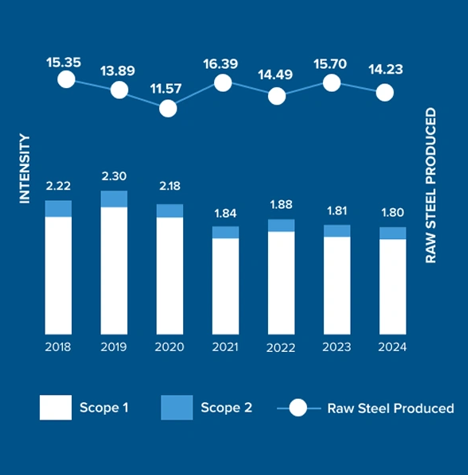Producing steel is carbon-intensive and we have a roadmap to get to net-zero Scope 1 and Scope 2 emissions by 2050. Roughly three-quarters of the GHG emissions from integrated steelmaking are associated with the use of coke and coal to melt iron in blast furnaces.
U. S. Steel has always strived to be on the leading edge of the most energy-efficient production of steel using blast furnaces. Simultaneously, we are making steel by melting recycled steel scrap using electricity in EAFs, which produces significantly less GHG emissions. U. S. Steel recognizes the importance of having both routes of steel production while transitioning to a lower carbon economy.
Our progress toward lowering our Scope 2 emissions has continued through 2024 with important milestones. For example, U. S. Steel’s second mini mill, BR2, opened in October 2024, which will reduce our GHG emissions intensity once operating at run-rate capacity. Entergy Arkansas’ Driver Solar project, which is located adjacent to the Big River Steel Works operations, came online in December in 2024 and is projected more than 555,000 megawatt hours (MWh) of solar energy annually, significantly increasing Big River Steel Works' use of renewable energy.
Along with strategic projects and partnerships across all our facilities, we continue to advance towards our GHG emissions reduction goals. We are committed to annual public reporting on progress against our GHG emissions reduction goals, as well as the measures being implemented to achieve them.
As we move full speed ahead toward reaching this target, we are focusing on process optimization as well as on the incorporation of EAFs into our footprint. Our greenhouse gas emission target reflects our continued commitment to improvement in production efficiency and the manufacture of products that are environmentally friendly.
GreenHouse Gas Emissions
2030 Goal
-20%
We have set a goal to reduce our
GHG emissions intensity Scope 1 and 2 by 20% by
2030 based on 2018 baseline levels.
GreenHouse Gas Emissions
2050 Goal
NET-ZERO
We have set an ambitious goal
targeting net-zero carbon emissions Scope 1 and 2 by 2050.
2024 TOTAL GREENHOUSE GAS EMISSIONS

The graph above show the absolute and intensity based GHG emissions for U. S. Steel wholly owned facilities for 2018-2024. The results are separated by Scope 1, Scope 2, and total GHG emissions for North America, Europe and Total Global Operations. Absolute measurements are presented as metric tons of CO2e, while intensity measurements are metric tons of CO2e per metric ton of raw steel produced.